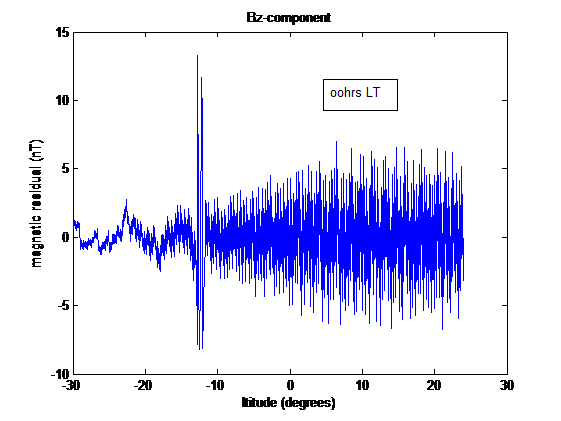Features of the Night-Time F-Region Currents Over Equatorial Africa (August, 2001)
Physics
DOI:
https://doi.org/10.14331/ijfps.2014.330072Keywords:
Ionosphere, Equatorial ionosphere, ionospheric current systems, magnetic fieldAbstract
In this paper, we present the features of the equatorial F-region current systems over equatorial Africa during nighttime on 05thAugust, 2001 observed at midnight. The observations have inferred from in situ CHAMP satellite measurements of the vector magnetic field. The magnitudes of the current along all the three magnetic field components of the Earth’s magnetic field varied considerably. The Bx-component recorded a diamagnetic effect of about 8nT, By-component recorded a current density of 5mA/m, and Bz-component reached a value of 3mA/m. The F-region dynamo, gravity dynamo and plasma-pressure gradients are the possible mechanisms for the occurrence of these currents. The signatures confined to the equatorial region bounded by the Appleton anomaly.
Downloads
References
Anderson, D., & Haerendel, G. (1979). The motion of depleted plasma regions in the equatorial ionosphere. Journal of Geophysical Research: Space Physics (1978–2012), 84(A8), 4251-4256.
Bilitza, D., & Reinisch, B. W. (2008). International reference ionosphere 2007: improvements and new parameters. Advances in Space Research, 42(4), 599-609.
Campbell, W. H. (2003). Introduction to geomagnetic fields: Cambridge University Press.
Heelis, R., Kendall, P., Moffett, R., Windle, D., & Rishbeth, H. (1974). Electrical coupling of the E and F-regions and its effect on F-region drifts and winds. Planetary and Space Science, 22(5), 743-756.
Kelley, M. (1989). The Earth's Ionosphere: Plasma Physics and Electrodynamics, Int. Geophys. Ser, 43, 437-455.
Lühr, H. GFZ German Research Centre for Geosciences The CHAMP Mission. from http://op.gfz-potsdam.de/champ
Lühr, H., & Maus, S. (2006). Direct observation of the F region dynamo currents and the spatial structure of the EEJ by CHAMP. Geophysical research letters, 33(24).
Lühr, H., Maus, S., & Rother, M. (2004). Noon‐time equatorial electrojet: Its spatial features as determined by the CHAMP satellite. Journal of Geophysical Research: Space Physics (1978–2012), 109(A1).
Lühr, H., Maus, S., Rother, M., & Cooke, D. (2002). First in‐situ observation of night‐time F region currents with the CHAMP satellite. Geophysical research letters, 29(10), 127-121-127-124.
Maeda, H., Iyemori, T., Araki, T., & Kamei, T. (1982). New evidence of a meridional current system in the equatorial ionosphere. Geophysical research letters, 9(4), 337-340.
Maus, S., & Lühr, H. (2006). A gravity‐driven electric current in the Earth's ionosphere identified in CHAMP satellite magnetic measurements. Geophysical research letters, 33(2).
Maus, S., MacMillan, S., Chernova, T., Choi, S., Dater, D., Golovkov, V., Mai, W. (2005). The 10th-generation international geomagnetic reference field. Geophysical Journal International, 161(3), 561-565.
Musmann, G., & Seiler, E. (1978). Detection of meridional currents in the equatorial ionosphere. Journal of Geophysics Zeitschrift Geophysik, 44, 357-372.
Park, J., Lühr, H., Stolle, C., Rother, M., Min, K., & Michaelis, I. (2010). Field-aligned current associated with low-latitude plasma blobs as observed by the CHAMP satellite. Paper presented at the Annales Geophysicae.
Rishbeth, H. (1971). Polarization fields produced by winds in the equatorial F-region. Planetary and Space Science, 19(3), 357-369.
Sridharan, R. (1998). Equatorial and Low Latitude Thermosphere-Ionosphere Interaction. PROCEEDINGS-INDIAN NATIONAL SCIENCE ACADEMY PART A, 64, 315-340.
Wickert, J., Reigber, C., Beyerle, G., König, R., Marquardt, C., Schmidt, T., Melbourne, W. G. (2001). Atmosphere sounding by GPS radio occultation: First results from CHAMP. Geophysical research letters, 28(17), 3263-3266.

Downloads
Published
How to Cite
Issue
Section
License
Copyright (c) 2014 Fundamental Journals

This work is licensed under a Creative Commons Attribution-NonCommercial 4.0 International License.










